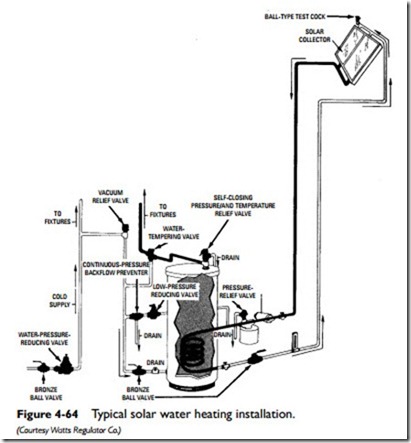Assembly and Installation of Manual Water Heaters
A great many installations of manual water heaters have given poor service, not because of any fault in the heater, but mainly due to the improper method of connecting the heater to the storage tank. This lack of good service can be largely overcome if a few simple installation rules are followed.
All recently manufactured range boilers have tappings provided in them for hot- and cold-water connections, specifically two tap- pings in the side of the tank 6 inches from the top and bottom as shown in Figure 4-63 to accommodate the circulating water con- nections, which should be made of 3⁄4-inch or larger pipe. The bot- tom of the tank has a tapping for connection to the drain or blow-off, which is used to drain water or sediment from the boiler. Circulating pipes between the heater and tank should be made as free from fittings and bends as possible.
The use of brass pipe on the hot-water circulating line from the heater to the tank is recommended, particularly for high-temperature circulation.
When required, unions should be placed as close to the heater as possible on the hot-water and cold-water circulating lines.
The placement of hot- and cold-water tappings 6 inches from the top and bottom of the tank allows free circulation, which results in relatively large-volume storage without overheating. It also eliminates short-circuiting of the water through the heater and provides ample sediment storage below the circulating line, thus preventing sediment from getting into the heating element.
Solar Water Heaters
Many of the valves and heating controls used with gas, oil, and electric water heaters can also be used in solar water heating systems. These components are designed to protect and control a solar water heating installation from a single source. A typical system is
shown in Figure 4-64. A specially designed thermostatic element (for 210°F to 250°F service) in a thermal bypass control should be included in the system to divert high-temperature water to a cool- ing section (see Figure 4-65). This prevents structural damage to the solar panels and improves system efficiency.
